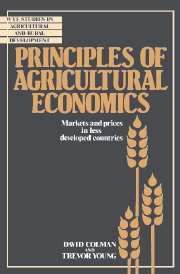Book contents
- Frontmatter
- Contents
- Acknowledgements
- 1 Introduction
- 2 Economics of agricultural production: theoretical foundations
- 3 Product supply and input demand
- 4 Topics in production economics
- 5 Theory of consumer behaviour
- 6 Economics of market demand
- 7 Developments in demand theory
- 8 Equilibrium and exchange
- 9 Analysis of agricultural markets
- 10 Welfare economics
- 11 Economics of trade
- 12 Food and agricultural policy
- Notes
- References
- Index
9 - Analysis of agricultural markets
Published online by Cambridge University Press: 06 July 2010
- Frontmatter
- Contents
- Acknowledgements
- 1 Introduction
- 2 Economics of agricultural production: theoretical foundations
- 3 Product supply and input demand
- 4 Topics in production economics
- 5 Theory of consumer behaviour
- 6 Economics of market demand
- 7 Developments in demand theory
- 8 Equilibrium and exchange
- 9 Analysis of agricultural markets
- 10 Welfare economics
- 11 Economics of trade
- 12 Food and agricultural policy
- Notes
- References
- Index
Summary
Introduction
Markets exist to facilitate the transfer of ownership of goods from one owner to another. Each time ownership of something changes hands, whether it be a goat or a bicycle, a price is determined. This is true whether the exchange of ownership takes place in a barter economy or using money as the medium of exchange. If in a particular barter transaction ten chickens are exchanged for a goat then the price of the goat is ten chickens and that of one chicken is one-tenth of a goat. Clearly it is impossible to trade in tenths of a goat, so that if the person originally owning the chickens had had only five he would have been unable to conclude a barter exchange with the goat owner unless the latter could have been persuaded to accept the much lower price of five chickens per goat. Putting together barter deals is a cumbersome way of achieving transfers of ownership. It is far easier to arrange this in a money economy, where chickens and goats can both be sold for units of currency. In this way the goat owner may be able to buy the chickens without having to sell his goat to the chickens’ owner. He can sell his goat at a money price equal to that of ten chickens, and then spend half of the notes or coins he receives on buying the five chickens on offer.
In the previous chapter exploring the nature of market equilibrium, the equilibrium price was presented as that which enabled the last marginal unit supplied to the market to be sold to a willing consumer for money.
- Type
- Chapter
- Information
- Principles of Agricultural EconomicsMarkets and Prices in Less Developed Countries, pp. 167 - 197Publisher: Cambridge University PressPrint publication year: 1989
- 1
- Cited by

